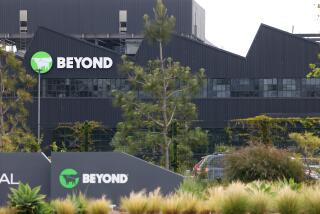They Have No Beef With Ronald
- Share via
NEW DELHI — This is the exotic land of sacred cows, where autos must dodge around the wandering cattle in the streets and the Hindu faithful would rather go hungry than bite into a juicy hamburger.
So it has been a curious thing these past few weeks, watching the hordes who are always in line, beef-less people who deserve a break today, getting up and getting away to McDonald’s.
They come on pilgrimage to the world famous golden arches--and they are curious, excited and even reverent. What awaits them are Vegetable Burgers, Vegetable McNuggets and five sandwiches made with mutton, which is meat in sheep’s clothing. The Maharaja Mac contains two all-mutton patties, special sauce, lettuce, cheese, pickles, onions, on a sesame seed bun.
Hearing this, many Americans might be tempted to applaud the portability of their nation’s culinary genius. But this would be wrong. To do so ignores the fact that next door to India’s first McDonald’s is the equally beef-less Nirula’s, a chain long known for serving its own vegetable burgers as well as the popular mutton-based Mahaburger.
Indeed, truth be told, the Maha has much to offer that the Maharaja does not, including a slice of tomato, generous swirls of grilled onions and a bun that is lightly toasted for added flavor. Nirula’s also offers pizza, foot-long heroes, a full line of bakery goods and 21 flavors of ice cream.
“I do not fear the competition,” said Paras Sandal, a supervisor at Nirula’s. This foolhardy statement was made while the customers at McDonald’s outnumbered his own by about 200 to six.
“I think we are more to Indian standards,” he nevertheless insisted.
McDonald’s genius, of course, is not in its cooking but in its marketing. To much of the world, the golden arches are a more familiar symbol than the stars and stripes. America brings to mind a mixed image of McDonald’s, Coca-Cola, Levi’s, Sylvester Stallone and Madonna. When it comes to low culture, the balance of trade hugely favors the United States.
At the current pace, a new McDonald’s opens somewhere on the planet every three hours, with two-thirds of the new outlets raising the arches on foreign soil. Ronald McDonald now smiles in 96 nations, with more than 7,000 international locations. The chain’s reigning sales champ is the one in Moscow’s Pushkin Square, which serves Beeg Maks.
An appropriate slogan might be: one world--one junk food, though adjustments are occasionally made for local tastes. In Norway, the McLaks is a grilled salmon sandwich with dill sauce. In New Zealand, the Kiwi Burger lays a fried egg and a slice of beet over the ground beef. In Saudi Arabia, there are separate dining rooms for men and women. Here in New Delhi, for the first time the challenge to McDonald’s was to entirely disassociate itself from bovine slaughter. Declaring itself a no-beef zone, the four-tiered, 150-seat restaurant opened Oct. 13. In accordance with Hindu tradition, its Indian owners offered a coconut in place of a human head as a bloodless sacrifice.
Immediately, the restaurant became a chic oasis for the upscale. People are often waiting more than an hour to get their fast food, standing outside in one of those tight, serpentine lines that look like intestines on an anatomy chart.
*
“I came because of the name,” said Anika Sabharwal, a thrilled college student. “It’s an international thing, a craze. You want to be a part of something that’s as big as the whole world.”
She had just finished dining on a Vegetable Burger, best described as a patty of rice smooshed together with peas, carrots, red pepper, beans and coriander.
“It was great!” she exclaimed, complaining only of the blandness of the bun and the stingy size of her hot fudge sundae. “I think they’ll need to change the quantity if they want to sell ice cream in India.”
Generally, the patrons have emerged well-satisfied, though some do qualify their praise.
“The cheese here has a stink to it, like it’s stale, though it may be that I’m not yet used to it,” said Suchi Shekhar, another college student. Her friend Neha Puri wondered, “What kind of menu has no pizza?”
Asoke Laha, the president of a Delhi software firm and a voice of cosmopolitan wisdom, wore a frown all too familiar to American parents. “I’m here because of her,” he said, nodding at his young daughter Joya. “McDonald’s is all she ever eats. We used to live in Boston. She became a McDonald’s junkie.”
Plans call for the arches to go up at 20 Indian locations, mostly in New Delhi and Bombay, by 1999. In a bow to national pride, the McDonald’s here cleverly assures customers that virtually all of its ingredients come from India, with buns from Punjab, lettuce from Tamil Nadu, pickles from Andhra Pradesh, cheese from Maharashtra.
Colonel Sanders, for one, was not so smart. Last year, he chose to open India’s first KFC in Bangalore, a thriving metropolis of 6 million--but also a place where a small group of farmers had declared guerrilla war against the invasion of Western multinationals.
In January, commandos in green shawls raided the restaurant, shattering all its windows and setting fires. To make matters worse, the Colonel shot himself in the drumstick: Government inspectors determined that the “hot and spicy” seasoning contained nearly three times the amount of monosodium glutamate allowed by India’s food protection laws.
Babloo Chaudhary, a building contractor, claims to have lunched at the new McDonald’s every day since it opened.
“I’ve also been to the ones in Bangkok and Hong Kong,” he said. “I’ve never been to the U.S., but I feel like I can eat like an American all over the world.”
More to Read
Eat your way across L.A.
Get our weekly Tasting Notes newsletter for reviews, news and more.
You may occasionally receive promotional content from the Los Angeles Times.










